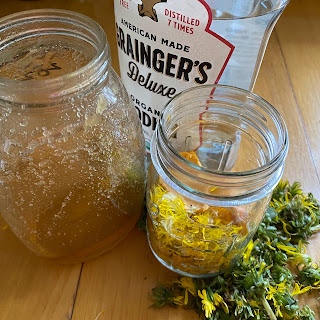I was tidying a section of the fenced-in "garden" and harvested a respectable bucket of Taraxacum officinale radix, better known as dandelion root. Some folks call this activity "weeding." I call it harvesting.
I cleaned and prepared the roots for the oven, where they gently roast until they're nice and dry. I leave them in the oven to cool, and double check them for crispy dryness before packing them in jars for storage and enjoyment in the seasons ahead.
How do I enjoy these roasted roots? I give them a rough grind in my suribachi (or any mortar 'n' pestle), and simmer them in water at least 20 minutes, strain 'n' sip 'n' enJOY. I often add more water for a second or third brew. I might add other botanicals that can take the decoction (that's herbalist speak for the simmer) to enhance the flavor, medicinal or nutritional value.
You might like to add a bit of organic cane sugar, maple syrup 'r sugar, or local honey to yours. You might like to add some spicy botanicals to make it chai-like. You might like to add a splash of local milk, or the cream off the top. Me... I prefer mine "straight up." Not only is this mellow, bitter brew delicious, it supports and sustains my physical being as an ally to general digestion, to liver 'n' gallbladder function, and then some.
Of course the leaves are delightful in salad, cooked as a green and as an addition to springtime soups. The petals - those beautiful, bright, sunshiny petals - are notorious for brewing liquid sunshine like dandelion wine 'n' mead and various elixirs and liqueurs, and I love adding them to my sourdough pancakes, muffins (and other baked goods).
I harvest the roots (and its other parts) from spring to autumn. I still have some dry roasted roots from last season, which delights me greatly.
So remember: Weeding can be harvesting and harvests equate to abundance and abundance is... everywhere in Nature. Respect that. Deeply.

































